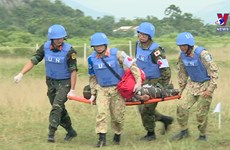Vietnam develops global COVID-19 early warning system

Hanoi (VNA) – An early warning system for COVID-19 was launched by the Institute of Preventive Medicine and Public Health (IPMPH) at the Hanoi Medical University (HMU) on March 1.
The system provides analyses on the disease threats and countries’ response abilities at http://covid19global.net.
Assoc. Prof. Tran Xuan Bach, Vice Head of the HMU’s Health Economics Department and project leader, said the system was based on research results issued by an international network of experts on epidemiology and disease control, as well as updated data released by reputable databases.
Besides counting infections, deaths and recoveries, it uses artificial intelligence to analyse and evaluate threats which may lead to outbreaks in different areas of the world in accordance with characteristics of the novel coronavirus (SARS-CoV-2), collective behaviour and ecological factors.
“There are many factors, such as the number of people currently confirmed in each area, the level of interaction and mobility, population density, weather, responsiveness and disease control capacity in each country,” said Bach.
 Assoc. Prof. Tran Xuan Bach, Vice Head of the Hanoi Medical University’s Health Economics Department and project leader, speaks at the 2019 Global Young Vietnamese Scholars Forum. (Photo: VietnamPlus)
Assoc. Prof. Tran Xuan Bach, Vice Head of the Hanoi Medical University’s Health Economics Department and project leader, speaks at the 2019 Global Young Vietnamese Scholars Forum. (Photo: VietnamPlus)
Input data allows the system to quantify the risks and speed of disease transmission. For example, it forecasts that risks outside China will outnumber those from mainland China.
Bach said research results were a dependable source of information for policymakers to discuss and closely collaborate with the group to come up with the optimal control strategies.
Head of IPMPH Le Thi Huong expressed her hopes for the system to serve as an innovative approach to fighting COVID-19.
According to the system, new infections may appear in Vietnam in March with the cities of Da Nang, Hanoi, HCM City and Nha Trang, which are popular among both local and foreign air travellers, among the most vulnerable areas. The chances have been rated at 21 percent, including 13 percent caused by risks from outside China.
Bach said response plans have to be developed for different locations and take into account local human resources and facilities. The plans must promote the engagement of the people across residential areas and villages to minimise impact of the disease.
The institute is encouraging people to together update the site.
From 59 cases reported in China in December 2019, the number of confirmed COVID-19 cases has so far jumped to nearly 85,000, causing over 3,000 deaths in more than 60 countries and territories.
On January 31, the World Health Organisation declared the novel coronavirus outbreak a public health emergency of international concern. It also emphasised the urgent need to coordinate international efforts to investigate and better understanding of the virus to minimise the threat in affected countries and to reduce the risk of further global spead./.
|
The early warning system for COVID-19 has been developed under a project on “National early warning system on global COVID-19 epidemics for risks assessing and emergency response planning” (EpiNEWS) for Vietnam, funded by VINGROUP Innovation Fund. |













